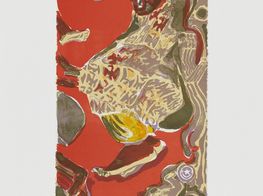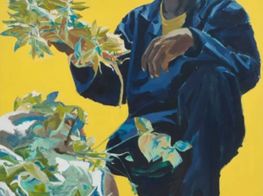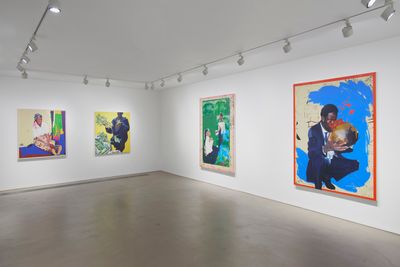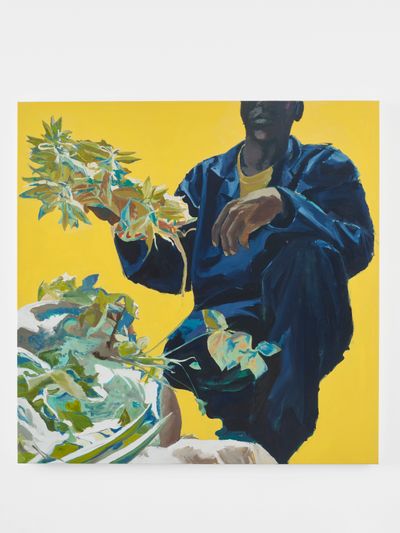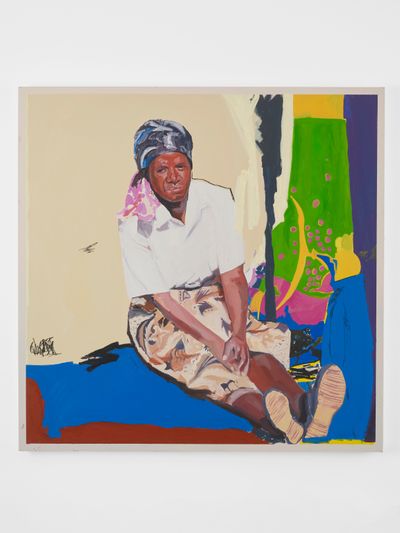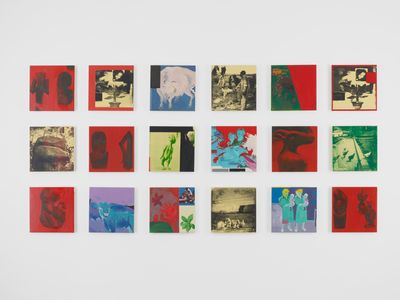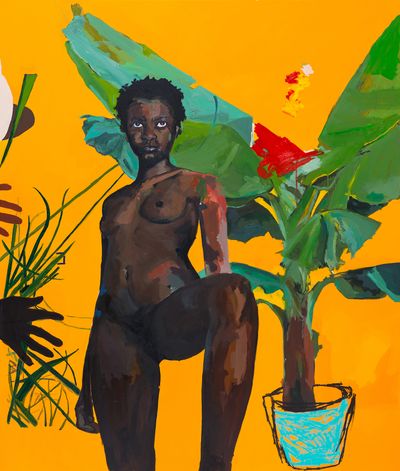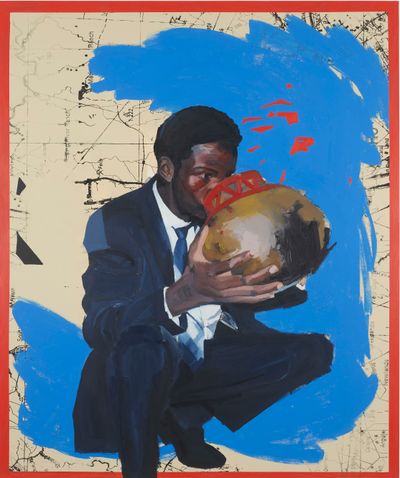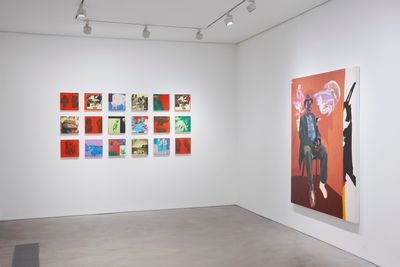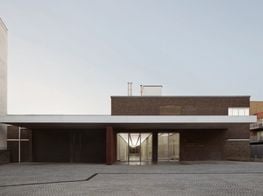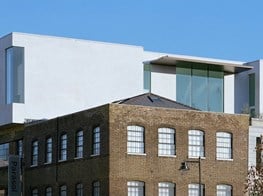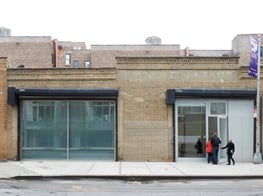Michael Armitage and Kudzanai-Violet Hwami on Painting
In Partnership with Gasworks
Michael Armitage and Kudzanai-Violet Hwami in conversation at Gasworks, London (29 October 2019).
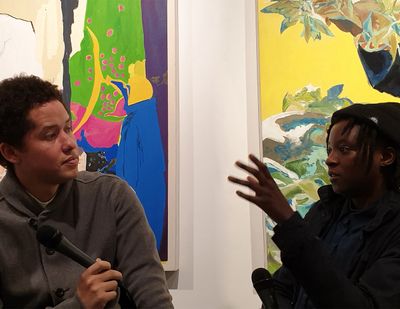
Michael Armitage and Kudzanai-Violet Hwami in conversation at Gasworks, London (29 October 2019).
At just 26 years of age, Kudzanai-Violet Hwami has made two enviable milestones this year. The Zimbabwean-born and London-based artist represented her country of birth at the 58th Venice Biennale alongside Georgina Maxim, Neville Starling, and Cosmas Shiridzinomwa; while her first institutional solo exhibition opened at Gasworks in London on 19 September through 15 December 2019.
The artist, who is commencing an MFA at the Ruskin School of Art this year, combines images sourced from the internet and family photo albums to create brightly coloured, large-scale canvases that explore representations of the black body, along with notions of diaspora, displacement, and identity.
On 29 October 2019, the artist joined Kenyan-born, Nairobi- and London-based artist Michael Armitage at Gasworks to discuss the conceptual and formal strains of their painting practices. Armitage's dreamlike paintings on lubugo bark cloth combine elements pulled from news media, internet gossip, and his own memories of Kenya to shed light on issues in global politics.
Hwami, who relocated to the U.K., also navigates geopolitical landscapes through her paintings, with the title of her exhibition at Gasworks, (15,952km) via Trans-Sahara Hwy N1, directly referencing the distance and route between London and her hometown in Zimbabwe. In 2018, the artist embarked on a residency at Dzimbanhete Arts and Culture Interactions Trust on the outskirts of Harare, where her memories and nostalgia of Zimbabwe were challenged by the political realities of the country along with the temporal gap separating her early years there.
In this edited transcript of the conversation between Armitage and Hwami at Gasworks, the two artists discuss how painting allows them to navigate their contexts, and the subject matter that allows them to do so.
MAOne of the things that I was taken by in this show is the intimacy of the images. They all feel familiar; I can imagine looking back at photos of my own family and they would look very similar to some of these paintings. I was wondering if that was a source that you go to, and if it's important that there's an intimacy to the sources and images that you use?
KVHI think to start off there needs to be that intimacy when making artworks, anyway. It needs to start from a point of direct reference or direct connection, and the images that you see in the show are direct references of my family and people I know, such as my partner. But as much as they are direct references, I also change the narrative and what they mean to me, in a sense.
MAIs it important for you to have that closeness to make a painting? Or do you feel it's not necessary?
KVHI don't think it's necessary, because in the past I've worked with paintings that dealt with the queer body, and in those paintings, I was sourcing imagery from porn sites and—
MAThat's when you hope your family doesn't pop up!
KVH[laughs] Yeah, that's when my family doesn't pop up. But I often sourced imagery from pornographic images because I guess that's a much easier access to the black body, and there are questions around that that I've just thought of now but that I hadn't assessed in the past.
MAAnd are there paintings in this group of works that you've approached in a similar way?
KVHIn a sense, yes. That painting behind you, Sitting by Sekuru's grave (2019), and that painting in the corner, Untitled (2019), are based off photographs that I sourced from my family album of people that I don't know, but I've conjured stories about them. It's the way that I've worked before, with the nude body.
For this show, I wanted to reflect back on when I returned to Zimbabwe in 2018 and did a residency at Dzimbanhete in Harare. Upon arriving, it felt like I was coming home; it was the first time I had been back to Zimbabwe since the age of 9 and I'm now 26. I was welcomed when I arrived, but I guess that welcoming could be questioned—was I welcomed because I'm an international artist, or because I have a deep connection with the country and they saw me as their own? Medicine Man (2019) is of a guy who was living at Dzimbanhete who helps the shaman. I was living in this house with the guy who runs Dzimbanhete, Chico, who lives with a whole village of people and one of those people is a shaman. I took photographs while I was there; it wasn't that I sourced images online, it came out of an interaction with the people who were living there at the time and an interaction with real Zimbabwean, or Shona persons.
MADid your perspective of Zimbabwe change?
KVHMy purpose for going there was to change the way that they see queer people, and then upon arrival there was a push—you feel like an imposer, because you're trying to push your own ideology that you've learned from abroad. I didn't want to do that, so instead I let myself be part of the environment, and I allowed myself to learn from them instead of imposing ideas of how I wanted Zimbabwe to be.
MAThroughout these paintings, you've created a sense of place by using maps and landscapes with huts and people outside, and so on. It seems like a very loaded decision to choose a map to create a sense of place in the paintings Newtown and Bira (both 2019) and then abstract it by painting out a lot of detail, and then to kind of reinvest in it by adding another image on top. How did this process come about?
KVHThe title of the show came from me using these maps, and initially I thought the entire show would be based on this sense of place. The map in both Newtown and Bira comes from a website run by this white Zimbabwean guy who is very nostalgic about Rhodesia and what took place in that time, and I used that map to inject the history of that place, and to talk of the time of which he's nostalgic. It's much more evident in the painting titled Dreamcatcher, which depicts an old man. Directly speaking about the past is speaking about the now, and I didn't want to be overly political about it, but in analysing Zimbabwe, I had to come to terms with the fact that the people who are currently running the country have failed ordinary Zimbabweans, and that was the idea behind putting the map, and its relation with that painting, Dreamcatcher.
MADid you also live in South Africa?
KVHI migrated to South Africa at the age of 9 and then my mum, little brother, sister, and I moved to the U.K. in 2008.
MAIn recent times there has been a huge amount of animosity towards Zimbabweans who have been fleeing Zimbabwe and moving to South Africa. Was that something that affected your thinking at all, or did you come across that at all within South Africa?
KVHYeah, I came across it suddenly in the last year I was in South Africa; I think it was 2008. So I came to the U.K. in December 2008, and around that same time I had a classmate who was a Xhosa guy and I remember him looking at me in a sinister way and he said, we're going to come to your house tonight and we're going to burn everything down. This was around the time that xenophobia was rising. With my work I try not to deal with those topics, because I see painting as an escape towards an otherworldly place, or an escape towards a much more celebratory place. I feel that when I see your work, but then you look deeper and then you see something else happening. The way you paint, it's quite dreamy.
MAI suppose that's also why I was quite interested in your choice of intimate images, because in a way I do the exact opposite and usually I actively avoid using an image source that's intimate, you know by using family photos or something like that. Rightly or wrongly, I have felt that to use images that have a familiarity within current affairs, news, and social media, is a way of thinking through an idea, and in the same way, I feel that referencing an image from any of these sources is equal to taking someone else's painting and using a reference from that. In this way, the sources are all on the same playing field and it's just about different ways of telling a narrative. I hadn't really wanted to muddle that with family or nostalgia or that sort of looking back. There's a step of remove, which for me is useful for thinking through ideas. But, you never know, maybe that will change.
KVHAt the start, I wasn't painting to look into my family; it was much more about looking at black bodies as objects, and I questioned that a little bit. I guess that's why I stopped painting in that way, but now I question why I'm using my family as references as well. I connect with these people, but really it's not authentic or true, the idea that I'm using the people in the painting in an authentic way because in a sense I'm removing their identity and creating a dramatisation of what might have taken place and what the painting means.
MAWhenever I'm asked about my sources, which I'm doing to you now—I always find that whatever answer I give is a little bit disingenuous, because it could be anything so long as it allows you to tell a story or to engage with an idea. As long as it allows you to make a painting, I've always thought anything goes. Draw from life if you wish; steal from someone's paintings, do anything you want. Do you feel a bit cavalier about that as well?
KVHIn a way, yes, but then I'm so self-critical that the intention of why I'm making something is always there. The intention of making a black person visible in a painting, is that because it's much more acceptable now, or am I authentically connecting with the idea of making, or is it something that's happening beyond that? Am I being pushed by other ideas, or am I painting because the times are allowing it? Do you know what I mean? Cause I always look at people like Stanley Whitney, and I think at the time he might have been painting because it felt that there was a void within modernism, for example. So, he might have felt that he had to fill that void.
MAThere's always the conversation around making work, but at the end of the day it's an incredibly intimate way of living your life with an object, and when you're committed to it, there are moments when it's quite frustrating, sometimes it's enjoyable, sometimes it's surprising, and you're just trying to figure out why people have been doing it for centuries. Like what you're saying with Whitney, I think the politics of it are one aspect, but then there's something else that happens when you're standing in front of a painting that you rely on to provide some sense of yourself within the world in a context, and that is where it gets really interesting, because then you don't have this idea of an intimate image, instead there is an intimate moment in front of you, and it shifts the subject from an intellectual mastication to this thing that's part of you. Is that why you paint? Because of that transformation?
KVHI paint because of the pleasure of painting and having a direct connection between the mind and the hand; the idea of being a master in painting or being skilful and proving to myself that I'm worth something—that I'm good at something. That's why I paint.
MAThat is really quite a brave thing to say, and I take my hat off to you, because I feel like pretty much everyone that picks up a brush wants to feel like they're good at it. Did you grow up with lots of art around?
KVHNo, I didn't, but the moment I was introduced to art, I was introduced to the great painters. I knew about Jenny Saville, for example—she was and still is this painter I look back to. It's not the theories about her work, it's really about her skilfulness and my wanting to be better, but you can never be better than another artist, you have to find a way to incorporate what they've done within your work. I remember going to a Robert Rauschenberg exhibition in 2016 I think, and I've constantly been looking at his work and referencing it.
MAI find that one of the challenges of painting is getting used to the fact that the things that are problematic and that don't hold up to the idea of being a good painter are the things that make your painting interesting, or the things that allow other people a way in. Otherwise, you just end up with a very shiny veneer that is academic and a good representation but isn't necessarily moving. I always think of Goya's paintings, which are just so awkward. Even when he's doing society portraits, for example, there's something in the language that is so close to caricature.
I'm quite taken by the hand of the guy drinking in your painting, Bira. His hand is absurdly big—he would be a very good swimmer and swim in circles. And then I was looking, and you don't have big hands! There are points that are awkward, and I think about your colour decisions, particularly in works where you've used underpainting very intelligently. In Bira, the underpainting is kind of more interesting than what's on the surface. It's great—it just brings it to life. I guess I'm interested in those moments in your paintings—they're the points that might be unintended, but they're defined by the things you chose to do.
KVHI know what you're saying about that painting—You and all your friends, I think it's titled. There's another painting, which I find visually similar to your painting The Chicken Thief (2019), called Boy with Dove. I often start a painting with a collage, and then the collage is projected onto the canvas and underpainted in acrylic, and then acrylic turns into oil paint, so there are these layers. In Boy with Dove, I chose not to cover up all the birds. I felt that the suggestion itself was enough—I guess that's a way for the viewer to then come in and fill in the dots. A lot of people have said it's a chicken, which is true because in the original image that I took in Dzimbanhete, the boy is holding a chicken he's about to slaughter. I don't want to fill in the gaps—I'd rather allow the viewer to fill them in.
I've looked at two paintings of yours that I like, Mpeketoni (2015) and #mydressmychoice (2015). In both of those paintings, there's reference to Western painting. The first time I saw Mpeketoni, it reminded me of Dance by Matisse.
MA#mydressmychoice, where there's a reclining nude, is based on Velázquez's Rokeby Venus at the National Gallery. There is a row of feet at the top of the painting, and at the bottom there are a couple of bush babies and some ground. That painting began when I saw a Twitter feed of these incidents in Nairobi when women wearing short miniskirts were taken off of mini buses and then they were stripped and molested because their skirts were too short, apparently. Unfortunately, it happens in way too many places, but when I was sent this video, which is horrific, the woman in the centre of the video was being pulled by maybe four or five guys, and they were pulling her arm and then dropping her and molesting her, but her body kept falling in and out of the pose of the Rokeby Venus, and that contradiction I found really problematic. The viewer has to be implicated in the painting the entire time, and I like the narrative of the painting of the Rokeby Venus, because it has also been attacked, as well as being held up as the ideal female nude painting. It is after all by Velázquez, so it's hard to dispute that. But I wanted to bring that into what was a horrific context, simply because that's how I saw her figure, and there was an issue and something unresolved in that.
KVHThe other painting, Mpeketoni, was actually based on an etching by Goya, which he also made into a painting, called Feminine folly. It's of these women standing in a circle with a blanket tossing a mannequin up and down. Mpeketoni is a place in Kenya where, during the World Cup, some militants—al-Shabaab guys—came in and shot something like 62 men who they took out from all the bars while they were watching the first game of the World Cup that was in Rio. I was thinking about the women who were all left to come together to clear the bodies away. I wanted to make a painting that showed women together doing that, and that image by Goya, as I steal from him regularly, felt very relevant and like that was right. —[O]

